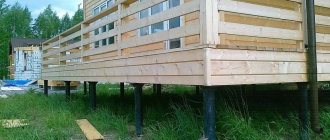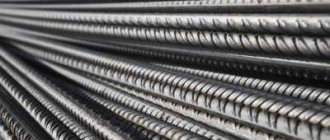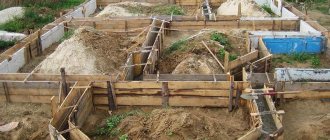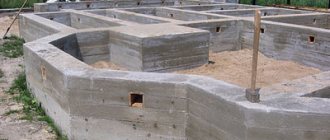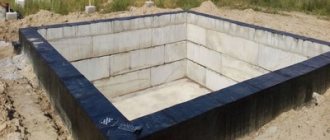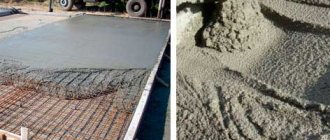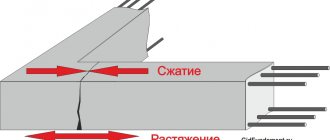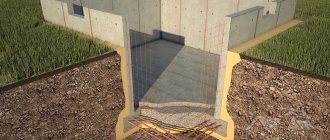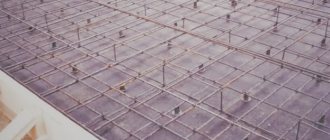The performance characteristics of strip foundations significantly exceed all alternative options for supporting structures for buildings and structures.
The tape allows you to create basements or basement floors, which is either completely excluded or significantly more difficult on other types of foundation.
At the same time, a feature of the material used for the construction of the tape is its instability to direct or indirect contact with water.
If waterproofing can easily cope with the first problem, then settling of airborne moisture on cold concrete or brick is much more difficult to deal with.
Let's consider the most effective way to solve the problem - insulating the strip foundation.
Technology for insulating strip foundations from the outside.
Insulation of the strip foundation with penoplex.
External insulation of the foundation is more important than internal insulation. Layers of hydro- and thermal insulation prevent freezing of the foundation and basement walls from the outside.
How to insulate a strip foundation? After digging a trench of the required size for the strip foundation, they immediately begin to insulate it . The soil along the bottom of the trench is compacted, a 10-15 cm layer of sand cushion is poured, which is also compacted. A layer of footing 3-5 cm thick is poured, sometimes insulating layers are applied directly to the sand cushion.
In addition to the insulation layer for the base of the foundation, it is possible to lay insulating coatings for the outer walls of the foundation.
Both the walls and the floor of the basement need to be insulated by first covering them with a layer of waterproofing.
Waterproofing is applied to the cement layer and insulation is laid. polymer bitumen mastic - is often used as waterproofing . Mold and fungi do not appear on it and are inedible for rodents. Bitumen mastic is elastic, so it practically does not crack.
The positive qualities of bitumen mastic help keep the insulation layer in good condition, preventing the penetration of moisture or pests, which could deteriorate the properties of the insulation or render the material unusable.
Bituminous mastic is applied by spraying with a special device or manually. To spray bitumen emulsion, an airless spraying apparatus is used - a mini asphalt distributor. The mastic is applied manually with a spatula, constantly adjusting it into an even layer. Bitumen emulsion is applied in 2-4 layers. The total thickness of the coating is 2-6 cm.
There is roll waterproofing for the foundation . Bitumen waterproofing membranes are often used. Coating layers are applied to the foundation, pre-heated from the bottom side with a gas or gasoline burner.
Sometimes self-adhesive bitumen roll materials are used, which makes the process of applying waterproofing easier and faster.
Insulation of shallow-depth tape.
Polystyrene foam is a universal insulation material. The main advantage is very low thermal conductivity. Foam plastic can be used to insulate the foundation at the base and along the outer part of the walls, as well as heated and unheated basements. The foam sheets are attached to the surface using a special solvent-free adhesive. If you need to change the size of any slab, the foam can be cut with a regular stationery knife.
To insulate the outer walls of the foundation, you need to choose sheets of foam plastic 20 cm thick. Glue is applied to the foam sheets on one side in several symmetrical dots, and they are immediately pressed against the surface. All joints are carefully sealed with glue. To insulate the foundation, foam plastic is glued to concrete or completely dried bitumen mastic (the coating is considered dry when it stops sticking). The foam layer is completely sealed by subsequent waterproofing.
If the foam covering is installed on the outside of the foundation, it can be plastered. Before applying the plaster, the foam plastic must be reinforced with fiberglass mesh using a special adhesive for facade work. The mesh is overlapped by at least 10 cm. The reinforcing mixture is applied in two stages, both times the layer does not exceed 2-3 mm. After the mixture has dried, it is smoothed with sandpaper for the subsequent application of the finishing layer.
Expanded polystyrene . In addition to low thermal conductivity, it is completely insensitive to dampness and moisture; mold and mildew cannot grow in it. Disadvantage: It gradually degrades under the influence of UV radiation. It is installed in the same way as a foam coating. When installed on the external walls of the foundation, it must be plastered.
Polyurethane foam does not require additional waterproofing coatings. In addition to its thermal insulation qualities, polyurethane foam does not allow or absorb water, and does not support combustion. It does not form fungi and mold. Polyurethane foam is not destroyed by rodents.
Insulation of strip foundation.
This insulation can be used in sheet form, secured with a special assembly adhesive for polyurethane. The layer of polyurethane foam coating for the foundation is on average 40-60 mm. You can make a seamless coating; for this, polyurethane foam is purchased, which is sprayed from special airless foam spraying installations. When sprayed, the coating dries quickly.
If the polyurethane foam is applied unevenly, it can be leveled by cutting off the protruding areas with a knife. The surface can be plastered or left unchanged for laying subsequent layers.
Mineral wool is made from basalt rocks (the most commonly used), fiberglass and slag. Withstands extremely high and low temperatures, therefore suitable for any climate, fireproof.
Mineral wool absorbs water, which causes mold and mildew to form. Dampening of the insulation can be avoided by sealing the mineral wool with layers of waterproofing on both sides. Mineral wool is prone to deformation, so only the outer walls of the foundation are insulated with this material.
Materials for thermal insulation
Various materials are used to insulate strip foundations. Often found in construction practice:
Styrofoam
Foam plastic, produced in accordance with GOST 15588-2014 “Polystyrene foam boards. Technical specifications" made of foamed polystyrene. Supplied in the form of slabs (sheets) 100 cm wide and up to 200 cm long. The most commonly used foam is PSB (pressless suspension polystyrene foam) with a thickness of 50 mm. GOST 15588-2014 allows its use in the operating temperature range from -100 to +80 °C.
The thermal conductivity coefficient of polystyrene foam is 0.038-0.041 W/m*K (K-Kelvin).
When choosing the thickness of thermal insulation from foam plastic, proceed from the following criteria:
- For regions with winter temperatures of 10-20 degrees below zero, the thickness of the foam layer should be at least 50 mm;
- For winter with a temperature of minus 20-30 degrees - at least 100 mm;
- At minus 30-45 degrees - at least 150 mm.
Insulation of the foundation from the outside consists of thermal insulation of its outer part and base.
Polystyrene foam is applied over waterproofing, which is bitumen, roofing felt or other waterproofing materials. Most often, foam plastic is glued to bitumen mastic with special adhesives.
When laying foam plastic sheets in several layers, the seams between the sheets of the inner and outer layers are not allowed to coincide. The outer slab of material must move at least 10 cm relative to the joint seam between adjacent lower slabs to ensure that “cold bridges” do not occur. Covered joints increase the effectiveness of the thermal barrier.
Extruded polystyrene foam
Extruded (or extruded) expanded polystyrene (EPS) differs from traditional foam in its production technology, which uses extrusion processes. Structurally, EPPS differs from PSB due to stronger molecular bonds that provide high strength characteristics. Eps foam from Penoplex and TechnoNIKOL companies is popular on the Russian market. This material is optimal in terms of quality/cost criteria for thermal insulation of underground structures. The service life is estimated at 50 years. Thanks to the presence of grooves on the plates, the installation of thermal insulation is simplified while simultaneously sealing the fastening of the sheets to each other.
Thermal conductivity coefficient: 0.03-0.033 W/mK, which is slightly better than polystyrene foam. Accordingly, the thickness of the heat-insulating layer of EPS is almost the same as for polystyrene foam. The insulation process is identical to the installation of polystyrene foam.
Polyurethane foam
By spraying a layer of polyurethane foam up to 50 mm thick on the outside of the foundation, we achieve complete filling of all irregularities, seams and recesses of the strip foundation. The technology of applying an insulating layer on a surface has appeared relatively recently and requires the use of special equipment. The thermal conductivity coefficient of polyurethane foam is 0.023-0.03 W/mK.
Foam glass
Foam glass is a good option for insulating the foundation, but it costs three times more than EPS, so we will leave it as an option for the prospect of cheaper technology.
Expanded clay
Expanded clay has a porous structure that prevents the penetration of cold air. Expanded clay should only be used in conjunction with waterproofing to ensure optimal thermal balance in the building. This method has only one advantage - it is low price. There are a lot of disadvantages, but the most significant one is that expanded clay picks up moisture over time and stops working as insulation. And even in dry form, its heat-insulating properties do not shine - the thermal conductivity coefficient is 0.1 W/mK.
Shallow insulated strip foundation.
Insulation of strip foundations with polystyrene foam.
If a shallow strip foundation is installed on heaving soil . To prevent soil freezing, thermal engineering measures are carried out for the walls and base of the foundation.
The foundation must be insulated horizontally and vertically at the bottom . The insulation layer is applied to the sand cushion, so 5 cm is added to the depth of the trench, depending on its thickness. The formwork for the foundation should be no less in thickness than the thickness of the pre-selected insulation.
For a shallow foundation, the same hydro- and thermal insulation materials are used as for strip foundations of any depth level. Preferably extruded polystyrene foam is used, which is laid out joint-to-joint and secured with special glue or bitumen mastic.
Insulation of strip foundations from outside technology.
The joints of any sheet insulation must be sealed with mastic or glue. If necessary, you can apply insulation in two layers; the location of the joints of the second row should not coincide with the first.
The list of insulation works includes leveling the risks of cracking of the foundation and walls. A drainage system is installed along the perimeter of the foundation . A closed system of drain pipes is laid at a slight slope.
Rain, melt, and groundwater entering the pipes do not affect the foundation, leading to dampening of the building, do not accumulate in the soil with subsequent freezing, but are drained through pipes into a drainage well.
Insulation of the strip foundation of a wooden house.
To what depth?
The tape is insulated over the entire area, including both areas immersed in the ground and those located on the daylight surface .
To do this, it is necessary to remove the soil to the entire depth of the trench (if an existing foundation is being insulated), or install an insulator directly during the construction of the foundation (the best option).
Partial insulation of individual areas , only the upper part of the tape, or other options for incomplete cutoff from the effects of cold will not bring a favorable result.
On the contrary, at the border of insulated and open sections of the tape, the process of moisture condensation will be activated, the level of thermal expansion of the tape will increase, which will create the preconditions for the formation of microcracks, the absorption of water into the concrete with subsequent destruction .
The problem can only be solved by complete, sealed installation of insulation on the entire working surface of the base.
Insulation of shallow strip foundations.
A shallow strip foundation is erected in the ground. least susceptible to frost heaving.
Insulation of shallow strip foundations.
And yet, its insulation from the outside is a mandatory stage of construction. in order to avoid heat loss from the room and prevent possible freezing of the soil by the sole of the support.
Using polyurethane foam
Methods for thermal insulation using foam are the most expensive, since installation will require special equipment and qualified craftsmen.
The cost of polyurethane foam itself is also quite high. The material resembles polystyrene in structure, but is inferior to it in terms of quality. Its durability is similar to high-quality foam.
The main advantage of polyurethane protection is the absence of joints and seams on the surface during application. The use of the material eliminates the need for waterproofing, since the foam itself performs these functions.
Application technology:
Foam spraying is carried out using a high pressure unit. A special gun sprays the finished composition onto the base at a speed of 350 l/min.
Before starting the installation process, you must make sure that the equipment is in working order and that there is an electrical outlet with a current of 220V. The foam is applied to a previously cleaned and dry surface without traces of oil in several layers to ensure maximum adhesion at the joint. The first layer should be from 5 to 10 mm thick, depending on the topography of the foundation. Performing thermal insulation using this method requires certain skills, so it cannot be done independently.
Technique.
Do-it-yourself strip foundation with insulation.
When installing protection against heat loss for a shallow-depth support, insulation is performed on the outer surface of a shallow strip foundation vertically and horizontally at its base. Most often, for this type of construction, insulation is used - extruded polystyrene foam. Penoplex practically does not allow heat to pass through. has high strength. moisture resistance and fire resistance.
The technology for insulating a shallow strip foundation consists of several stages:
- Preparatory work. Along the entire perimeter of the supports, they dig out a trench with their own hands, with a depth to the base and a width equal to the average depth of soil freezing in the region plus 5 cm. The concrete surface is cleaned to insulate it from dirt. and, if necessary, leveled with cement mortar.
Heat losses through the floor of an insulated shallow strip foundation.
- Waterproofing. The side part of the base and base is coated with bitumen 2 times or pasted over a hot layer of polymer bitumen mastic with roofing felt or PVC membrane.
- Covering the waterproofing layer on top with geotextile.
- Installation of sand and gravel base in the trench. the thickness of which is equal to the thickness of the pillow under the support itself. In this case, the sand and gravel layer should have a slope from the walls of the house.
Insulation of a buried strip foundation.
- Pouring a concrete screed 3-5 cm thick and coating with polymer bitumen mastic for waterproofing.
- Pasting a shallow strip foundation with extruded polystyrene foam slabs 5 cm thick. Special glue is applied along the perimeter and diagonals of the insulation panel. then pressed tightly against the side surface of the foundation structure. The slabs are connected to each other by tongue-and-groove ends. To prevent the appearance of cold bridges, seams and gaps are filled with polyurethane foam.
- Laying penoplex on a concrete screed in a trench. See photos of thermal insulation on the website
- Installation of a vapor barrier layer over insulation. located on horizontal and vertical planes. from a profiled membrane or dense polyethylene film. Vapor barrier material sheets are laid overlapping. Seams and edges are taped with special adhesive tape.
- Installation of drainage system. Corrugated drainage pipes are installed along the perimeter of the shallowly buried strip structure 30 - 50 cm below the bottom of the strip to drain groundwater and melt water. The drainage pipe is laid on a crushed stone base.
- Backfilling of the trench with sand with layer-by-layer compaction.
- Construction of a concrete blind area around the house.
Insulation of shallow foundations. performed in accordance with building codes and regulations. will prevent its destruction from the forces of frost heaving and groundwater and significantly reduce heat loss from the room.
Which is better to choose and why?
All of the above insulation materials have fairly good moisture resistance and thermal insulation capabilities.
When choosing one or another insulation, you need to focus on:
- Ease of installation - if you are insulating a horizontal surface, you can use expanded clay. For smooth vertical surfaces, it is enough to glue foam boards.
- Water content in soil and air - in case of a high percentage of moisture content in the soil, it is better to use a material that has the highest airtightness, for example, penoplex or liquid polystyrene foam.
- The difficulty of the strip frame is that gluing foam boards onto the “dodgy” structure is a very labor-intensive process, which can also lead to a significant loss of hermetic characteristics due to the large number of gaps. In this case, it is better to choose liquid polystyrene foam.
- The price of the material - if you need to stay within strict budget limits without losing the effectiveness of insulation, and subject to other conditions, it is possible to use less expensive components - polystyrene foam and expanded clay. If the issue of price is not so pressing, then you can insulate yourself with expensive analogues that have higher quality characteristics.
Features of insulation of shallow foundations.
Insulation of the strip foundation of the house.
Since one of the features of a shallow foundation is the fact that its base is located above the soil freezing level, especially close attention should be paid to its insulation. First of all, it should be understood that it is necessary to insulate a shallow foundation in all planes: both horizontal and vertical . This will make it possible to most effectively influence the outflow of heat from the room and prevent freezing of the soil under the foundation.
Most often, polystyrene foam is used as a material for insulating a shallow strip base.
Long-term practice clearly demonstrates that even a very small layer of this material, used for vertical insulation, reduces heat loss by at least 20%.
Insulating a strip base with polystyrene foam is a unique method, and all because the material is distinguished not only by excellent heat-saving properties, but also by a high level of moisture resistance. In addition, this technology is easy to implement.
Scope of application (MZFL)
Shallow foundations are used in the construction of structures on slightly heaving and non-heaving soils with low moisture content. These are sandy and sandy loam soils.
The main criterion is the groundwater level. It should be 0.5 m below the foundation depth.
Important! Most clay soils are classified as medium- and high-heaving, so the construction of MZFL on these types is accompanied by problems. Since the shallow type of foundation is between non-recessed and recessed, the load-bearing capacity is assessed as average
Since the shallow type of foundation is between non-recessed and recessed, the load-bearing capacity is assessed as average.
MZFL technology is used for structures:
- country houses and frame houses;
- timber structures;
- outbuildings;
- baths;
- sheds;
- fences
Important! Structures made of foam blocks, gas blocks and brick houses with a shallow foundation are not suitable. It can be used in combination with other types of bases
For example, in combination with piles. For heavy structures, a pile-strip foundation is suitable because... The load-bearing capacity increases due to bored supports. The design must comply with SNiP 2.03.01-84 in terms of strength and resistance to deformation.
Preparation for insulation of the foundation.
Insulation of the strip foundation from the outside.
Before you begin insulating a shallow foundation with expanded polystyrene from the outside, you should do some preparatory work. First of all, you will need to prepare a tool and material, the thickness of which should be selected taking into account external characteristics.
Experts recommend using extruded polystyrene foam for work such as insulating strip foundations.
First of all, the foundation must be dug around the entire perimeter and the surface of the base must be thoroughly dried from the outside. It is better to choose slabs for insulation with a thickness of at least 10 cm. When the concrete base is completely dry, it should be waterproofed. This point is especially significant if groundwater passes in close proximity to the foundation.
Various materials can be used for waterproofing work. For example, these can be water-based or polymer-based mastics. Care must be taken to ensure drainage of the entire area in the area of the foundation. Later it can be covered with a blind area.
At the bottom of the trench you will need to pour a small layer of gravel and sand, which must be compacted as thoroughly as possible. A perforated pipe is laid on top of the resulting cushion and covered with a mixture of sand and gravel.
We should not forget for a second that waterproofing the base is a very significant stage of work, and therefore its implementation should be approached with the maximum degree of responsibility.
How to work correctly with corrugated pipe?
It is difficult for beginners to understand how to correctly route a wire through a corrugated pipe for electrical wiring. Although there is nothing complicated about this, you just need to follow certain steps:
- the required length is measured locally and cut, and then the wire is cut with side cutters;
- you need to hold the broach so that it does not get lost in the pipe;
- a tourniquet is made, which should be tight;
- the harness inserted into the corrugation must be attached to a metal broach;
- The joint areas are wrapped with electrical tape.
Carrying out the installation
After placing the wiring, the corrugated pipe is fixed every 20 cm with special fasteners. The clamps are first attached to the corrugation, and then to the surface. A special device is used to pull the cable through the corrugation.
Stainless steel corrugation
Features of insulation installation.
Insulation of shallow strip foundations.
The technology for insulating a shallow foundation with polystyrene foam involves gluing slab material to the foundation walls using a special adhesive. It is strongly not recommended to use mixtures containing organic solvents for this purpose.
The glue must be applied pointwise to the insulating material. After which the plate must be firmly pressed to the base and fixed in a certain position for a short period of time. The result will be better if strip insulation technology is used. In this case, work should begin from any of the lower corners of the foundation. It is more expedient to lay the top layer of polystyrene foam in a checkerboard pattern. This will help ensure good seam joining.
Upon completion of installation of the insulation, the entire surface is carefully sealed . so that there are no gaps between the plates. To do this, you can use glue or foam.
When the insulation of the shallow foundation with expanded polystyrene is completed, the trench can begin to be evenly filled with sand and soil. The latter should be compacted well to avoid settling.
It will not be possible to insulate the entire basement of the building. In addition to providing the house with additional thermal insulation, such a step will make the foundation even stronger, which in turn will increase the durability of the building itself.
Types of FMZ
Tape
It is most popular in country house construction, as well as among individual developers carrying out construction work on their own.
It is used both for the construction of wooden and heavier stone structures. Such a shallow structure is a continuous strip of concrete evenly loaded by the walls of the structure.
There are several options for its construction:
- reinforced concrete block with an upper reinforcing belt;
- reinforced concrete block with lower and upper reinforcing chords;
- monolithic with two reinforcing belts;
- prefabricated monolithic with fittings.
Columnar FMZ
Can be used in the construction of wooden, timber, brick and stone buildings.
It consists of pillars that are installed at each corner of the house, as well as at the junction of internal and external walls. The “step” between the pillars should not exceed 2 meters.
To build a shallow columnar foundation, a pit is made, the depth of which should be about 1 meter, after which rings of reinforced concrete are placed in it, subsequently compacted with sand and covered with concrete slabs.
Useful tips.
Insulation of shallow strip foundations.
- If polystyrene foam insulation technology is used, the thermal insulation layer must be treated on top with glue for finishing work. This will allow the insulation to maintain its performance characteristics for a longer period of time.
- To increase the protective functions of the foundation of the house, it is recommended to additionally insulate the blind area. In this case, work should be done along the entire perimeter of the building. Any material can be used, including polystyrene foam.
- The insulation should be laid only after arranging the blind area cushion and drainage, as well as laying the waterproofing material.
- A concrete screed must be placed on top of the insulation. As an alternative, laying paving slabs can be used.
- If the construction of the building was carried out on soil characterized by a large freezing depth, it is strongly recommended to take care of additional protection of the thermal insulation layer from various types of mechanical damage. Brickwork on top of polystyrene foam insulation is best suited for this purpose.
- Insulation must be carried out for all types of foundations, regardless of the type of soil on which the house was built.
- Without some construction experience, it is strongly not recommended to insulate the foundation on your own. In such a situation, the best solution would be to turn to experienced professionals who know their business very well and are able to complete work of any degree of complexity in the shortest possible time.
When choosing a company for base insulation, you should pay attention not only to its experience in the relevant market sector, but also to reviews from existing clients.
Recommendation: A good review article, from it you will learn about the insulation of shallow strip foundations. Pay special attention to the joints between the insulation; they should be without gaps and insulated. Otherwise, moisture will get into the cracks, lift the insulation and destroy the foundation. If you don’t notice in time, and most likely you will, you will end up losing a lot of money.
Basic mistakes
The main mistake that is often made when insulating a foundation is loose installation of the insulator, which results in the formation of cold bridges .
They actively form condensation and become overgrown with frost or ice.
It is impossible to correct the situation without excavating soil from the sinuses of the trench , so it is necessary to carefully monitor the density and tightness of the insulator installation. The second common mistake is installing the material only from the outside or from the inside.
This does not give a sufficient effect, since both layers each work in their own mode . They complement each other and allow you to get the expected result only when installed together.
Glue selection
One of the ways to apply glue is pointwise, in slides.
In the summer and when the surface of the concrete base is flat, it is easier to glue it onto a special mixture.
For ease of unloading and transportation, manufacturers produce it in bags of 25-30 kilograms.
The main thing here is to choose the right brand with heat-insulating properties. It is desirable that the composition contains microfibers, which provide additional strength after drying.
Temperature conditions for working with adhesives outside are +5-32 degrees Celsius. When stirring the glue, use low-speed equipment, such as a mixer.
Foam for installation
In winter, it is more reasonable to use foam; it is not afraid of sub-zero temperatures, and the fixation time is 48 hours. The glue makes it possible to install dowels (fungi) after 3 days.
The choice of adhesive in winter for insulating strip foundations, in particular with penoplex, is obvious.
Mastic is like glue
Mastic based on bitumen resins is also applicable if all the insulation remains below ground level. It is applied with a brush in a thick layer directly onto the sheet, pressing tightly, we fix it to the concrete wall with plastic dowels.
The main thing is to cover the entire wall with such mastic in one layer a day before installation.
Seams and locks are also coated after shrinkage.
